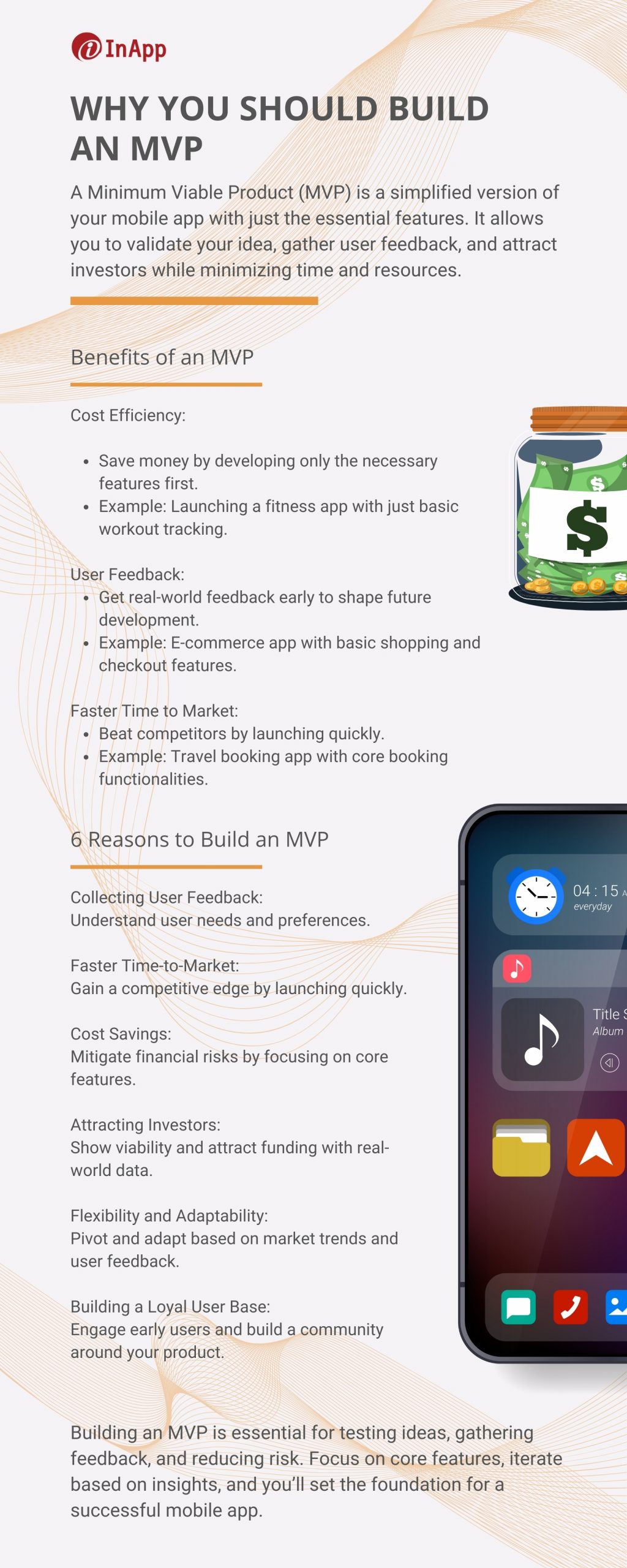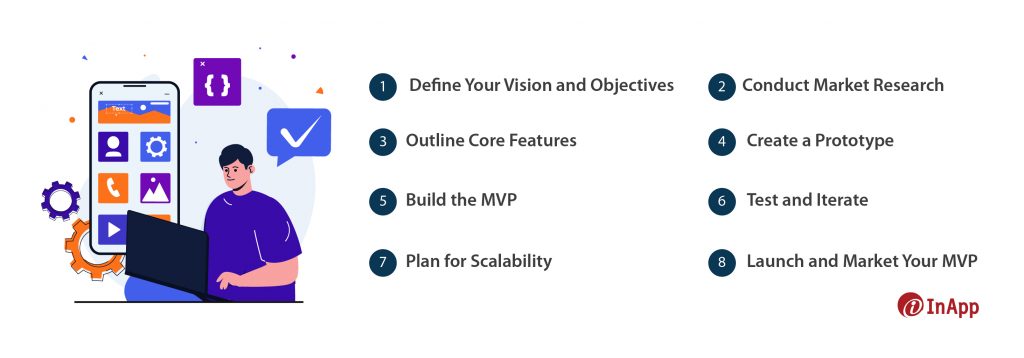In today’s fast-paced digital world, creating a Minimum Viable Product (MVP) for your mobile app is crucial. An MVP allows you to test your idea with minimal resources, gather valuable user feedback, and attract potential investors. Focusing on the core features allows you to validate your concept quickly and efficiently, saving time and money.
In this blog, we’ll explore the importance of MVPs, delve into effective strategies, share best practices, and highlight funding opportunities to help you build a successful mobile app.
What is an MVP?
A Minimum Viable Product (MVP) is the most pared-down product version that can still solve the core problem it was designed to address. The concept focuses on delivering a product with the minimum set of features necessary to satisfy early adopters and provide feedback for future development. By launching an MVP, businesses can test their ideas in the real market with minimal resources, reducing the risk of building a product that fails to meet user needs.
Benefits of MVP
1. Cost Efficiency: Consider a startup developing a fitness app. Instead of building a fully-featured product with meal plans, workout videos, and social features, they launched an MVP that tracks basic workout routines and provides simple progress charts. This approach reduces initial development costs and allows the startup to gauge user interest before investing in additional features.
2. User Feedback: Imagine an e-commerce company testing a new shopping app. By releasing an MVP with essential shopping and checkout features, they can gather user feedback on the overall experience. This feedback helps prioritize improvements and ensures the final product aligns with user expectations.
3. Faster Time to Market: A travel booking app can benefit from an MVP by quickly entering the market with essential booking functionalities. This allows the company to attract early users and gain a competitive edge, while gradually adding advanced features based on user feedback.

Difference Between Prototype & MVP
A prototype and a Minimum Viable Product (MVP) serve distinct purposes in the product development lifecycle. A prototype is an early, often incomplete, model of a product used to explore concepts, design, and functionality. It is typically used for internal testing, gathering initial feedback, and refining ideas before actual development begins. Prototypes are crucial for visualizing the product and understanding user interactions without investing significant resources.
In contrast, an MVP is a functional version of the product with just enough features to satisfy early adopters and provide actionable insights for future development. An MVP is launched in the market to validate the product idea, gather user feedback, and iteratively improve the product based on real-world data. Unlike prototypes, MVPs are meant for actual users and focus on solving the core problem while minimizing resource expenditure.
From a business standpoint, an MVP is more valuable than a prototype because it allows companies to test their assumptions in a live market, attract early users, and secure funding based on real user feedback. Prototypes, while essential for initial design and concept validation, do not provide the same level of market validation and user insights.
Differences between MVP and Prototype
| Prototype | MVP | |
| Purpose | Explore concepts and design | An initial version of the actual product |
| Development Stage | Early, pre-development | Core features to solve a primary user problem |
| User interaction | Limited, often internal | Broad, with actual users |
| Functionality | Incomplete, basic features | Core features to solve primary user problem |
| Feedback | Initial design feedback | Real-world user feedback |
| Time to market | Not intended for market release | Early market entry |
| Business Value | Concept validation | Market validation, user acquisition, funding |
6 Reasons Why You Should Build an MVP
In today’s competitive market, launching a product successfully requires more than just a great idea. Building a Minimum Viable Product (MVP) is a strategic approach that can significantly enhance your chances of success. Here are six compelling reasons why you should build an MVP for your mobile app:
- Collecting User Feedback
One of the primary benefits of an MVP is the ability to gather valuable user feedback early in the development process. By releasing a product with only its core features, you can observe how users interact with it and what they truly need. This feedback is crucial for understanding user preferences, identifying potential issues, and prioritizing features for future development. Engaging with real users from the start ensures that your final product aligns with their expectations and delivers a better user experience.
- Faster Time-to-Market
Speed is a critical factor in the tech industry. Building an MVP allows you to bring your product to market much faster than if you were to develop a fully-featured product from the outset. By focusing on the essential features, you can launch quickly, start building your user base, and establish a presence in the market. This early entry can give you a competitive edge and enable you to capitalize on market opportunities before your competitors.
- Cost Savings
Developing a full-fledged product can be expensive and time-consuming. An MVP helps mitigate financial risks by allowing you to test your idea with minimal investment. By focusing on the core functionalities, you reduce development costs and avoid spending resources on features that may not be necessary. This cost-efficient approach is particularly beneficial for startups and small businesses with limited budgets, allowing them to allocate resources more effectively and increase their chances of success.
- Attracting Investors
Securing funding is often a significant challenge for new ventures. An MVP can serve as a powerful tool to attract investors by demonstrating the viability of your product. Investors are more likely to fund a project that has already been tested in the market and has shown potential. An MVP provides tangible evidence of user interest and engagement, making it easier to convince investors of your product’s value and future prospects.
- Flexibility and Adaptability
The development process is inherently unpredictable, with market trends, user preferences, and technological advancements constantly evolving. An MVP offers the flexibility to adapt to these changes quickly. By starting with a basic version of your product, you can pivot and make adjustments based on user feedback and market demands. This adaptability ensures that your product remains relevant and competitive, reducing the risk of failure due to unforeseen changes in the market.
- Building a Loyal User Base
Launching an MVP allows you to start building a loyal user base early on. Early adopters are often enthusiastic about trying new products and can provide valuable insights into how your product is being used. Engaging with these users helps create a sense of community and loyalty, which can be crucial for your product’s long-term success. Additionally, these early users can become advocates for your product, spreading the word and attracting more users through word-of-mouth marketing.
How to Develop an MVP?
Developing a Minimum Viable Product (MVP) is a strategic process that involves several critical steps. An MVP allows you to test your product idea with minimal resources, gather valuable user feedback, and iteratively improve the product. Here’s a high-level guide on how to develop an MVP:

1. Define Your Vision and Objectives
a. Identify the Problem:
Understanding the problem your product aims to solve is the first step in developing an MVP. Conduct thorough market research to ensure there is a real need for your solution. This foundational step helps you align your product with the market demand and sets the stage for successful development.
b. Set Clear Goals:
Define what you want to achieve with your MVP. Outline measurable objectives such as user acquisition, feedback collection, or proof of concept. Having clear goals will guide your development process and provide a benchmark for evaluating your MVP’s success.
c. Establish Success Criteria:
Determine the key performance indicators (KPIs) that will help you evaluate the success of your MVP. These criteria will provide a framework for assessing whether your MVP meets its objectives and where improvements are needed.
2. Conduct Market Research
a. Analyze Competitors:
Identifying existing solutions and analyzing their strengths and weaknesses is crucial. Determine what sets your product apart and how you can improve on current offerings. This competitive analysis will help you position your MVP effectively in the market.
b. Understand Your Target Audience:
Create detailed user personas to understand your target audience’s needs, preferences, and pain points. Engage with potential users through surveys, interviews, or focus groups to gather insights. This user-centric approach ensures your MVP addresses real user needs.
3. Outline Core Features
a. Prioritize Features:
List all potential features for your product and use techniques like the MoSCoW method (Must-Have, Should-Have, Could-Have, Won’t-Have) to prioritize them based on importance and feasibility. This prioritization helps you focus on delivering the most critical functionalities first.
b. Define the Core Functionality:
Focus on the essential features that solve the primary problem your product aims to address. Ensure these features deliver the core value proposition of your product, making it valuable to users from the start.
4. Create a Prototype
a. Sketch Wireframes:
Creating basic sketches or wireframes to visualize the layout and functionality of your product is an important step. Focus on the user flow and ensure it is intuitive and straightforward. Wireframes help you map out the user experience before development begins.
b. Develop a Low-Fidelity Prototype:
Use tools like Sketch, Figma, or Adobe XD to create a simple, clickable prototype. Share the prototype with stakeholders and potential users for initial feedback. This early feedback can help you refine your design and functionality before full development.
5. Build the MVP
a. Choose the Right Technology Stack:
Selecting the appropriate technology stack based on your product requirements and team expertise is crucial. Consider factors such as scalability, flexibility, and ease of integration to ensure your MVP can grow with your business needs.
b. Develop Core Features:
Focus on building the prioritized core features identified in the earlier steps. Ensure the product is functional, reliable, and provides a good user experience. This focused development approach helps you deliver a product that meets user needs effectively.
c. Implement Basic Analytics:
Integrate analytics tools to track user behavior and gather data on how the product is being used. Set up metrics to measure the KPIs defined in the vision and objectives step. Analytics provide valuable insights for future iterations.
6. Test and Iterate
a. Conduct Internal Testing:
Perform thorough testing to identify and fix bugs and issues. Ensure the product meets quality standards and provides a seamless user experience. Internal testing helps you catch major issues before public release.
b. Launch a Beta Version:
Release a beta version to a small group of early adopters. Collect feedback on usability, functionality, and overall satisfaction. This beta testing phase provides real-world insights and helps you make necessary adjustments.
c. Iterate Based on Feedback:
Analyze the feedback from beta users and identify areas for improvement. Implement necessary changes and enhancements based on user input. This iterative process ensures your MVP evolves to better meet user needs.
7. Plan for Scalability
a. Gather Comprehensive Feedback:
Continuously collect feedback from users and stakeholders. Use this feedback to guide future development and feature additions. Regular feedback ensures your product remains aligned with user expectations.
b. Prepare for Future Development:
Plan for scaling the product by considering additional features, integrations, and enhancements. Ensure your technology stack and infrastructure can support future growth. A well-thought-out plan prepares you for long-term success.
c. Evaluate and Refine:
Regularly evaluate the product’s performance against the success criteria. Refine the product based on data-driven insights and user feedback. Continuous evaluation helps you stay competitive and relevant in the market.
8. Launch and Market Your MVP
a. Create a Marketing Plan:
Develop a comprehensive marketing strategy to promote your MVP. Use channels like social media, email marketing, and content marketing to reach your target audience. Effective marketing helps you attract and engage users.
b. Engage with Users:
Build a community around your product by engaging with users through forums, social media, and events. Encourage user-generated content and testimonials to build credibility. Active engagement fosters loyalty and advocacy.
c. Monitor and Adapt:
Continuously monitor the performance of your MVP. Be prepared to adapt and make changes based on user feedback and market trends. Staying flexible ensures your product can evolve with changing market demands.
How much does it cost to build an MVP?
The cost to build an MVP can vary widely, typically ranging from USD 10,000 to USD 100,000. This variation depends on factors such as the complexity of your product, the features included the target market, and the development team’s expertise. A simple MVP with basic functionalities will cost less, while a more complex MVP with advanced features and integrations will be more expensive. It’s essential to define your core requirements and budget accordingly to ensure you get the most value from your investment.
To Sum Up
Building an MVP is a crucial step in the product development process. It allows you to test your ideas with minimal resources, gather valuable user feedback, and make data-driven decisions. By focusing on core features and iteratively improving based on real-world insights, you can significantly increase your chances of creating a successful product. The benefits of an MVP—such as cost savings, faster time-to-market, and reduced risk—make it an indispensable strategy for startups and established businesses alike.
If you need assistance in developing an MVP, we’re here to help. Our team of experienced professionals can guide you through every step of the process, from defining your vision to launching and iterating your product. Get in touch with us today to start building an MVP that not only meets your business goals but also delivers exceptional value to your users.
